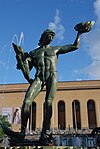Älvsborg Bridge
- Machine translation, like DeepL or Google Translate, is a useful starting point for translations, but translators must revise errors as necessary and confirm that the translation is accurate, rather than simply copy-pasting machine-translated text into the English Wikipedia.
- Do not translate text that appears unreliable or low-quality. If possible, verify the text with references provided in the foreign-language article.
- You must provide copyright attribution in the edit summary accompanying your translation by providing an interlanguage link to the source of your translation. A model attribution edit summary is
Content in this edit is translated from the existing Swedish Wikipedia article at [[:sv:Älvsborgsbron]]; see its history for attribution. - You may also add the template
{{Translated|sv|Älvsborgsbron}}to the talk page. - For more guidance, see Wikipedia:Translation.

The Älvsborg Bridge (Swedish: Älvsborgsbron) is a suspension bridge over Göta älv in Gothenburg, Sweden, connecting the island of Hisingen with the mainland. It was designed by Sven Olof Asplund, and inaugurated on 8 November 1966 by Swedish communication minister Olof Palme.[1] The total length of the bridge is 933 metres and the distance between the pylons ("main span") is 417 metres, while the clearance below the deck is 45 metres. This clearance is well below the international standard for the largest cruise ships (65 metres), so many such ships have to dock outside the bridge. The pylons are 107 metres tall, making the bridge one of Gothenburg's most prominent landmarks. It takes its name from the mediaeval castle of Old Älvsborg, the ruins of which are located just a couple of hundred metres along the riverbank from the southern pylon.
The bridge was painted green for the 1995 World Championships in Athletics, which Gothenburg hosted. Work started in 1993 and used about 36,000 litres of paint.
The bridge acted as the finish line for the 2005–06 and 2014–2015 Volvo Ocean Race.
References
- ^ Martin Grill (8 November 2016). "Älvsborgsbron fyller 50 år" (in Swedish). SVT Nyheter. Retrieved 8 November 2016.
External links

- Älvborgsbron at Structurae
- Pictures

- v
- t
- e
- Metropolitan Gothenburg
- Gothenburg
- Hisingen
- Partille
- Mölndal
- Gothenburg Municipality
- Inom Vallgraven
- Canals
- Gothenburg archipelago
- Boroughs and districts
- Port
- Lilla Bommen
- Bohuslän
- Västergötland
- Västra Götaland County
- West Sweden
- Götaland
- Kammarrätten i Göteborg

- Timeline of Gothenburg
- Bragebacken
- William Chalmers
- Comediehuset
- Discothèque fire
- Eriksbergs Mekaniska Verkstad
- Fortifications of Gothenburg
- Gothenburg Riots
- Gothenburg Exhibition
- Kungsporten
- Lindholmen Castle
- New Älvsborg
- Old Älvsborg
- Älvsborg Fortress
- Götheborg
- Sjukhusspionaffären
- Societetsskolan
- Swedish East India Company
- Säröbanan
- Torslanda Airport
- Vauxhall
communications
- Angeredsbron
- Fattighusån
- Central Station
- Göta älvbron
- Kungsportsplatsen
- Götatunneln
- Chalmerstunneln
- Lundbytunneln
- Tingstadstunneln
- Gothenburg tram network
- Västtrafik
- Västtågen
- Landvetter airport
- Säve airport
- Denmark ferry
- Public transport
- West Link
- Commuter rail
- Gårdatunneln
- Lisebergslinjen
- Hisingsbron
- Stombussarna
- Nils Ericson Terminal
- Styr & Ställ
- Marieholmstunneln
- Älvsborg Bridge
- Älvsnabben
streets and parks)
- Allum
- Avenyn
- Backaplan
- Eriksberg
- Frölunda Torg
- Heden
- Nordstan
- Gustaf Adolfs torg
- Järntorget
- Kungstorget
- Kungsgatan
- Linnégatan
- Drottningtorget
- Götaplatsen
- Korsvägen
- Kungsportsplatsen
- Brunnsparken
- Bältesspännarparken
- Botanical Garden
- Ramberget
- Slottsskogen
- Feskekôrka
- Vinga Lighthouse
- Wieselgrensplatsen
- Garden Society
- Delsjön
and entertainment)
- Barken Viking
- Bergakungen
- Draken
- Palladium
- Göteborgs Konsthall
- Museum of Art
- Röhsska Museum
- Gamla Ullevi
- Ullevi
- Scandinavium
- Frihamnen
- Liseberg
- The Göteborg Opera
- Stora teatern
- City Theatre
- City Museum
- Röda sten
- Universeum
- Museum of World Culture
cultural events
- Gothia Cup
- Gothenburg Culture Festival
- Gothenburg Book Fair
- Partille Cup
- Gothenburg Film Festival
- Hammarkullekarnevalen
- Swedish Exhibition and Congress Centre
 Main category
Main category












